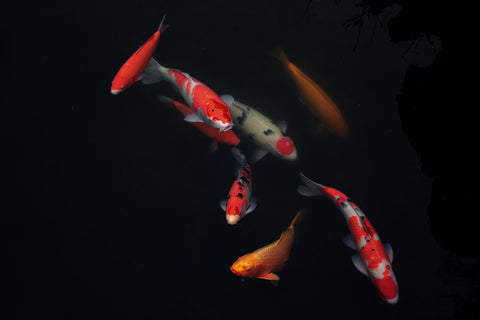Koi Fish: The Meaning Behind the Special Carp
Tagged with:Art and Design
Share
Koi fish have intrigued and inspired for centuries. They are rich with symbolic significance especially in Japanese and Chinese culture and history. Known universally as a symbol of strength, perseverance, love, bravery and dedication, enthusiasts collect both the living carp as well as items or art.

WHAT IS KOI?
The koi fish is a fresh-water carp commonly bred to celebrate its beautiful colour patterns and scales. The fish is kept in ponds or aquariums as decorative or symbolic reasons.
The word “koi“ is Japanese for carp, used to describe all carps, even the less flashy types with muted colours There are over 120 types of koi today
WHAT DOES KOI SYMBOLISE?
Sometimes called “living jewels”, the koi fish has become a famous symbol of beauty, love, and prosperity throughout the world.
Koi is associated with strength and perseverance in many legends, two in which we’ve included below.
THE CHINESE KOI FISH WATERFALL LEGEND

Depiction of the Koi Waterfall Legend (left). Artwork by kGoggles
Legend says that long ago, there was an abundance of golden koi fish in the Yellow River in China. They made their way upstream, going against the current, building strength and perseverance. Their golden hue made the river shimmer as if it was a river of gold.
Halfway upstream, they came to a large waterfall, an impossible height that is too high to traverse. This waterfall is known as the “Dragon’s Gate” in Hunan province. Most of the koi turned back, going with the current to safer ground. However, some koi stayed and attempted to jump and surpass the waterfall. Some of them got halfway, but then pummelled back downstream after they’ve lost momentum and energy.
The spirits of the river watched the koi try over and over again, making fun of them as they found it amusing.
This went on for one hundred years, the group of koi continued to try and swim up the waterfall but always stopped at exactly that waterfall. At each attempt the koi made it slightly further, gaining technique and strength as they practiced that waterfall.
The spirits continued to make fun of the koi, knowing that it’s such an impossible feat to make it past the waterfall.
One koi tried a different strategy. It went down to the bottom of the river, built up as much speed as it could, and leaped out of the water. It swam as hard as it could up the walls. Somehow, it reached the top of the waterfall, and continued to swim upstream.
The spirits were silenced watching that scene - how the koi succeeded in the impossible. Knowing the multiple attempts that the koi have tried over the years,
The spirits transformed the koi into a golden dragon as a reward for its achievement. In the Chinese culture, a golden dragon is the ultimate symbol of power and strength. That is also how the waterfall is known to be Dragon’s Gate - through this popular fable.
Lladró’s Koi figurine (left). A samurai (right)
JAPANESE KOI FISH AND SAMURAI WARRIORS
In Japanese culture and myth, the koi fish is associated with a few different myths and legends. The most notable is its association with Samurai Warriors. Samurai Warriors are known for their loyalty, strength and bravery. The koi’s migration upstream in rivers through waterfalls is not an easy one, as they swim with such strength and ferocity that they are compared to samurais.
Interestingly as well, when a koi fish is caught, it does not wriggle and bounce about, instead it stoically stays still. Even as a fisherman’s knife descends on them, the koi stays still - accepting its fate just like how a samurai would in honour.
LLADRÓ’S KOI FISH SCULPTURE
The koi in this piece is of the popular Kohaku variety and Sanke variety .
Lladró made a Koi sculpture limited to 2000 pieces, where two Koi fishes swim around a lotus flower. The colourful sculpture is an elegant way to add colour to your decor, a realistic and luxurious representation of “living jewels“.
Koi fish are known to swim in pairs, and are naturally known in many cultures as a symbol of love and affection, just how these two fishes swim side by side in matrimony.
It wasn’t till the early 1800s that the Japanese started to breed for colour, creating the many (up to 70) varieties of koi available today. The two kois are of the popular Kohaku variety and Sanke variety.
LALIQUE'S DOUBLE KOI FISH SCULPTUR
Lalique's crystal Double Fish Small Sculpture
Lalique Double Fish Small Sculpture in clear crystal was designed in 1953 by Marc Lalique, with the two fishes emerging from the water and chasing each other.
Symbol of prosperity and perseverance, the Koi fish has often inspired artists.
The Double Fish sculpture depicts two carps gushing from water in a movement evoking infinity. This model is now available in a small size. The satin-finished crystal, emblematic of Lalique, highlights the finely carved scales.






